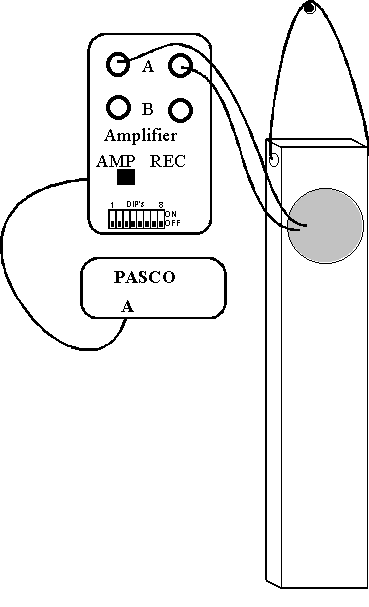Laboratory #4: Vibrational Modes of a Metal Bar
Objective:
In this lab we will measure the bending modes of an aluminum bar. We will determine the overtone series and the dependence of the frequencies on the length of the bar. The results are quite different from a vibrating string.
Equipment:
- Computer and PASCO Interface.
- PASCO breakout box.
- Aluminum bar.
- Piezoelectric transducer.
- Ruler.
Diagram:

Instructions:
- Start the PASCO and load Lab4.sws.
- Select a bar and connect it to the amplifier box. The piezo electric transducers are VERY delicate. Be careful with them.
- With the bar hanging as shown, gently tap the bar. Try tapping the bar at different points and in different ways. You should see the spectrum analyzer respond with low frequency signals.
- Record the lowest three frequencies and the length of the bar.
- For each frequency in step 4), find a point on the bar where you can pinch the bar without damping out the vibration and record the distance from the bottom of the bar. This determines the position of a node for that mode.
- Repeat 3) - 5) for two more bar lengths. Make sure you end up with three different lengths.
DATA:
Bar #1. Length of bar =
|
Mode: |
1 |
2 |
3 |
|
Frequency [Hz] |
|
|
|
|
Position of node from bottom of bar. [cm] |
|
|
|
Bar #2. Length of bar =
|
Mode: |
1 |
2 |
3 |
|
Frequency [Hz] |
|
|
|
|
Position of node from bottom of bar. [cm] |
|
|
|
Bar #3. Length of bar =
|
Mode: |
1 |
2 |
3 |
|
Frequency [Hz] |
|
|
|
|
Position of node from bottom of bar. [cm] |
|
|
|
Questions:
- Sketch the first three transverse modes. Do the nodes agree with where you found them to be?
- Are the transverse modes harmonic? In other words, find the ratio of overtones with the fundamental. They should follow the pattern 1f, 2.76f, 5.40f, (8.93f). How close do they follow this? Does this work regardless of the length of the bar?
|
Length of bar, L |
f2/f1 |
f3/f1 |
| |
|
|
| |
|
|
| |
|
|
- Dependence of the frequency of vibration on length. First fill in the following table:
|
Length of bar, L |
Fundamental, f1 |
L*f1 |
f1*Ö
L |
f1*L2 |
| |
|
|
|
|
| |
|
|
|
|
| |
|
|
|
|
|
Length of bar, L |
2nd overtone, f2 |
L*f2 |
f2*Ö
L |
f2*L2 |
| |
|
|
|
|
| |
|
|
|
|
| |
|
|
|
|
|
Length of bar, L |
3rd overtone, f3 |
L*f3 |
f3*Ö
L |
f3*L2 |
| |
|
|
|
|
| |
|
|
|
|
| |
|
|
|
|
From these tables, how does frequency depend on length? Do you have the same dependence for each overtone?

